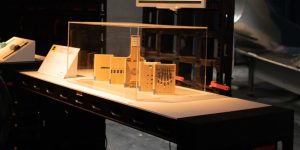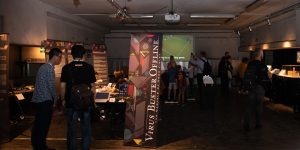Device Art

Bunko Gakki
Maywa Denki (JP)
Bunko Gakki is a musical instrument that is the same size as a Japanese paperback (A5 size). The user can easily carry it. It has a modular structure that fits into a bookshelf.

Solekit
Maywa Denki (JP)
*Solekit* is a craft kit that makes funny movements. It uses only one solenoid, driven by 5-volt power source.

Zihotch
Maywa Denki (JP)
*Zihotch* is a wristwatch that announces the current time when the user dials “117.” The voice is programmable so that the user can hear various people announcing the time.

Virus Buster Offline – The marvels of Code Violet
Gluccie Collaborations (JP)
The scene of *Virus Buster Offline* takes place in Japan in the near future. Through an avatar, people can dive into the Internet world, which has been infected by a brutal computer virus, Code Violet, which must be defeated by the players. The aim of this project is to allow participants to increase their physical activity by using elements of gamification. Participants wear an activity meter to collect points. With continuous participation, points accumulate and characters in the game evolve. This device art work combines the fields of medicine and art.

The Society of Stools [16]
Takeshi Ozu (JP), Aki Yamada (JP)
In many crowded urban places, such as train stations, you often find yourself in a weird situation: everyone around you is at your arms’ reach, yet they are strangers. *The Society of Stools [16]* is a flock of sixteen stools that move autonomously. The chairs escape and try to keep away from surrounding objects, including people. During this immersive experience, you may feel like you are one of them, or just feel isolated, since they are not willing to let you get closer.

El-Astrocade
Yuta Kozaki (JP), Felix Dollack (DE), Takeshi Ozu (JP), Rina Katsube (JP)
Childhood obesity is a worldwide public health issue. It is reported that overweight children and young adults are more likely to stay obese during their life. To tackle this issue, we made use of gamified exercise and proposed the large projection game *El-Astrocade*. This game was originally implemented in the world’s largest virtual reality system at the University of Tsukuba. It encourages players to be more active, while showing us how physical activity is enjoyable and fosters teamwork and communication.

Big Robot Mk.2
Hiroo Iwata (JP)
This video installation shows the largest movable robot in the world. Large humanoid robots, such as Gundam or Macros, are popular in Japanese animation and Manga. What if robots of this kind appeared in the real world? The existence of real large-scale robots may inspire the audience to be courageous. Thus, it has potential as an art form. The Big Robot Project aims to develop the world’s largest rideable robot. The Big Robot Mk.2 is an extension of the *Big Robot Mk.1* which was exhibited at Ars Electronica 2016.

Device Art Chronicle
Machiko Kusahara (JP)
The term “device art” is already part of the vocabulary of contemporary art. The Device Art Chronicle demonstrates how the concept was developed within the Device Art Project, aiming to explain the prehistory of media art, and how local and global features are connected. We were able to define features that characterize Japanese media art (e.g. playfulness), which can be better understood by relating them to earlier cultural traditions. Nevertheless, the essence of device art is also international and its features are shared by many works of media art.

Device Art 2019
PhD. Program in Empowerment Informatics, University of Tsukuba
Device Art is a new form of art that brings out the essence of technology through new materials and mechatronic devices. This concept challenges the traditional paradigm of art by merging technology, art and design.


